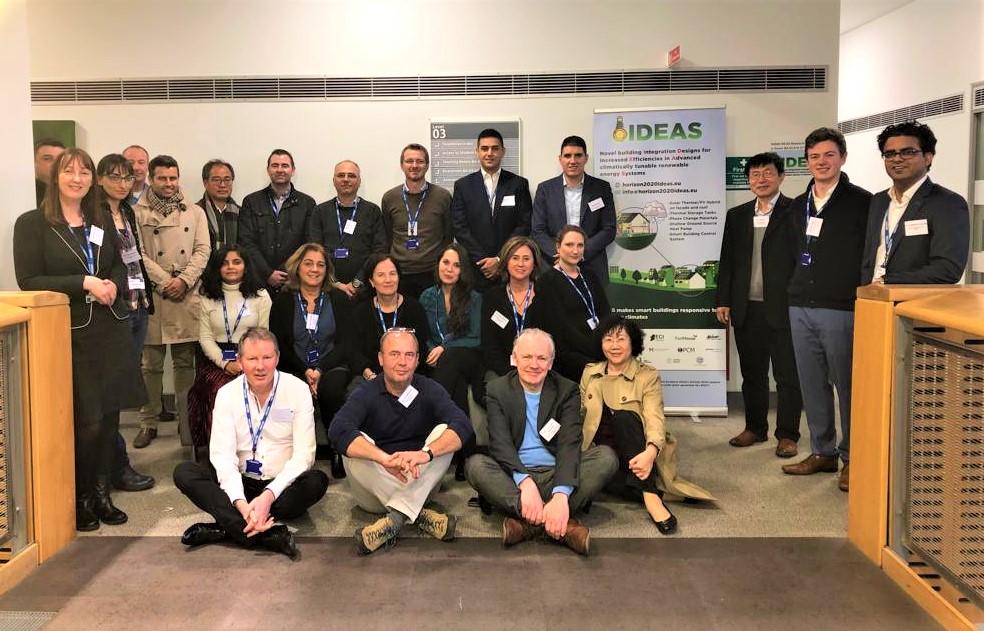
Introduction
Hosted by the Ulster University in their Belfast Campus, partners from throughout Europe came together to share information about the progress of the research which is moving apace.
Welcome from Belfast School of Architecture
A welcome presentation was given by Prof Neil Hewitt, the Head of the Belfast School of Architecture and the Built Environment. He explained the different Ulster University campuses and research centres, with a focus on the research relevant to this project at the Centre for Sustainable Technologies, (location of the lab visit on Tuesday 11th November).
Update from the Coordinator
Professor Sarah McCormack, Trinity College Dublin, presented an overview of the project as a reminder to the consortium. She outlined the submitted deliverables and congratulated all the WP participants who had completed and submitted deliverables on time. She also outlined the next deliverables for M6 – M12.
Professor McCormack also presented information on the recent clustering event in Brussels on October 8th. Links to all the projects present at the event were included in the ppt and the consortium was asked to look at the projects to see where overlaps existed.
Research Progress Updates
Workpackage 1
Sarah McCormack gave an overview of WP1 outlining the tasks and deliverable timelines for the project with particular emphasis on M6-M12. Other WP1 participants presented an update of the work undertaken.
Bill Cass (TCD PhD researcher) gave a presentation on the latest work on the Luminescent Downshifting (LDS) layer. The fabrication process has been optimised and layers have been successfully demonstrated at 12.5 x 12.5 cm – solar cell size. These layers will be directly spin coated on to the solar cells. BASF Violet dyes have been chosen and currently sourcing a supply for the fabrication of 132 LDS for the prototype system for UNIFE.
Anita Ortega (TCD PhD researcher) gave a presentation on the latest work on CPC and system manufacture. The system assembly is currently underway. Six systems are being fabricated; 2 reference systems; a PV reference system (33 cells) and PV system (33 cells) with LDS layers; along with 4 luminescent CPC systems (33 cells each with LDS layers).
Maria Joao Brites presented her work undertaken in LNEG on dye synthesis. She presented the characteristics of the dyes, were some dyes have a very low quantum yield in solution but high in solid which should be of interest to LDS development.
Sara Pastor Fabregat presented the work undertaken at LEITAT on finding a supply of suitable dyes and the synthesis of metal nanoparticles. Many different shapes and sizes were presented which can be used in this project. Silver nanorods have been synthesized and need to be transferred into chloroform for application in the LDS layer.
Work package 2
Mingjun Huang presented an update on recent work undertaken at Ulster University on WP 2 – outlining the tasks and deliverable timelines. Recent work on modelling of Thermal Energy Storage (TES) as well as coupling with heat pumps was presented. The models developed can be used or shared within the project for overall system integration.
Khao Lee presented his work on TRNSYS modelling of thermal energy storage and heat pumps and discussed the possibility of inclusion in other software such as Matlab.
Workpackage 3
Michele Bottarelli outlined the tasks and deliverable timelines for WP3 as well as summarising the submitted deliverables. He described recent work undertaken at UNIFE and presented preliminary designs of the IDEAS system & TRNSYS options for modelling as well as mock ups of the prototype installation. He is focusing on two systems with power output ranging from 50kW to 2-7kW respectively.
Workpackage 4
Marko Jelic presented the work ongoing in WP4 on the demand side management system development. Matlab is being used for the model which can integrate TRNSYS codes from the other WPs easily. The results of the optical model be fed into the thermal model and the results of thermal model fed into the electrical model.
On the remaining work packages, there were valuable contributions made by all the full and associate partners.